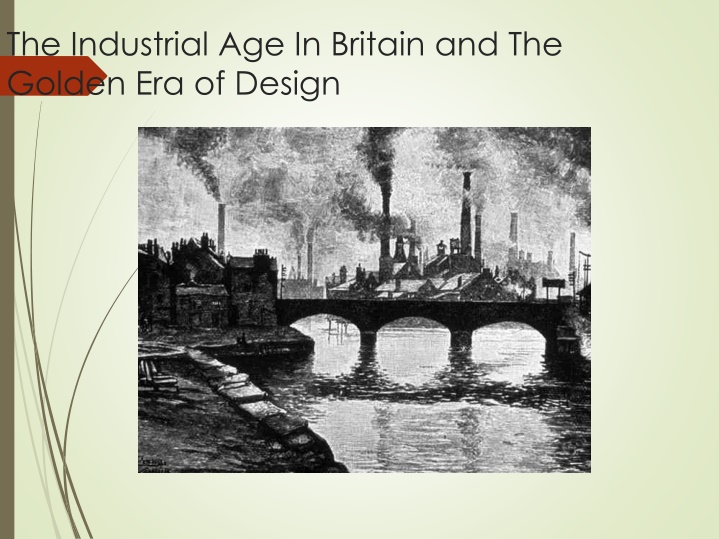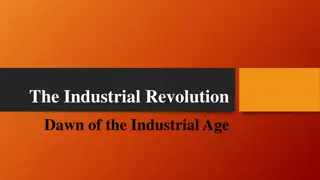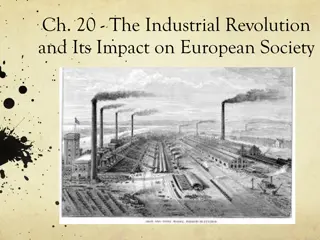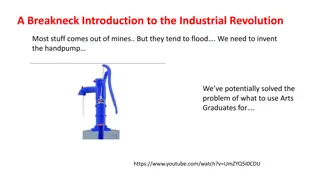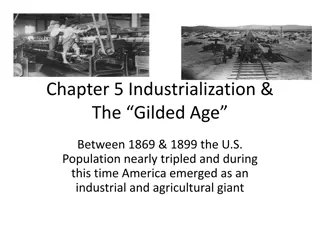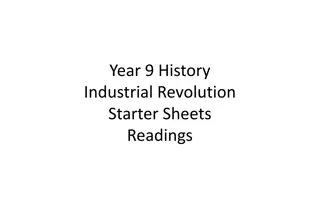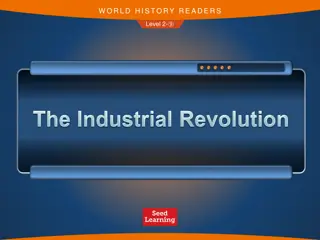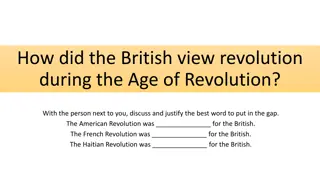The Industrial Revolution in Britain: Transforming Society and Economy
The Industrial Revolution in Britain, starting around 1760, marked a significant shift as machines replaced manual labor, leading to the rise of industrial factories and rapid urbanization. Textile manufacturing, fueled by inventions like the Spinning Jenny and Spinning Mule, played a crucial role. The abundance of coal and iron ore, political stability, and colonial resources positioned Britain as a hub of industrial innovation. This era saw the emergence of a new class system, transportation advancements, and the foundation of a commercial society.
Download Presentation

Please find below an Image/Link to download the presentation.
The content on the website is provided AS IS for your information and personal use only. It may not be sold, licensed, or shared on other websites without obtaining consent from the author.If you encounter any issues during the download, it is possible that the publisher has removed the file from their server.
You are allowed to download the files provided on this website for personal or commercial use, subject to the condition that they are used lawfully. All files are the property of their respective owners.
The content on the website is provided AS IS for your information and personal use only. It may not be sold, licensed, or shared on other websites without obtaining consent from the author.
E N D
Presentation Transcript
The Industrial Age In Britain and The Golden Era of Design
The Industrial Revolution Breakthroughs In science and technology, made it so that jobs that were once done by hand, by rural farmers and workers. Were now being done by machines in huge industrial factories. It was the time that people were first being regulated by clocks and factory bells and not by their own time. Rural populations declined, as towns and cities sprung up, by people in search of steady work and pollution began to increase rapidly. It all began around 1760. Before the revolution, most people lived in rural areas working as farmers. The class system did exist at this time but it was not as evident as it would become, it consisted of the lower class(farmers), middle class(almost non-existent at the time and the upper class which were small in number. Rural farmers lived and worked on the land that they had and worked by their own time. There was no education around those areas at the time, so many people could not read or write, and due to malnourishment and poor nutrition many people died young.
The Industrial Revolution One of the first industries to be industrialised was textile manufacturing. For the poor rural population this was a big issue if not a tragedy, as they had few ways of earning money, other than the unreliable income of farming. Before the industrialisation of textiles, many rural people in particular women, began cottage industries in which they made yarn, that was then sent to weavers and made into cloth. These however were among the first people to be replaced by machines, such as the ``Spinning Jenny`` and the ``Spinning Mule.`` The building of factories was one of the biggest turning points of the Industrial revolution, people who worked in factories now had to leave at a designated timje time in order to get to work on time. Workers had to move their families from rural areas to big and crowded cities in order to live closer to the factory. Women and children mostly worked in mills and textile factories, while men and boys worked in coal mines and factories.
The Industrial Revolution The Spinning Jenny The Spinning Mule
The Industrial Revolution The reason for the industrial revolution taking place in Britain, is because its had large deposits of coal and iron ore. Britain was also a politically stable country and being the worlds leading colonial power meant its colonies were a source of raw materials and a marketplace. Advances in transportation also added greatly to Britain s wealth with the new inventions being made. Such as the steam engine, invented by Thomas Newcomen, by the 1770s the steam engine was improved by James Watt, and it went on to power machinery, Locomotives and ships. Communication also became easier , due to the invention of the telegraph by William Cooke and Charles Wheatstone in 1837. With Britain s increased wealth, the need for banks also happened. With the new wealth came cheaply produced goods and through that came the basis of a commercial society. The class system also changed greatly with the new workforce, producing a large middle class and both an increased wealth and lower class.
The Industrial Revolution The Steam Engine The Telegraph
The Industrial Revolution References http://www.history.com/topics/industrial-revolution https://www.youtube.com/watch?v=d4joqYycnqM https://www.youtube.com/watch?v=JhF_zVrZ3RQ http://vle.cdcfe.ie/mod/resource/view.php?id=31936 https://www.mtholyoke.edu/courses/rschwart/ind_rev/images/IR36GR21 x1.jpg http://www.saburchill.com/history/chapters/IR/images/091107012.jpg http://www.geocities.ws/industrialrevinventors/spinningmule.gif http://270c81.medialib.glogster.com/media/a1/a1ff681343dccc2756100 4957199e469d408f443435dadef951e97909645a3b9/v310052-steam- engine-designed-by-james-watt-spl-jpg.jpg http://eandt.theiet.org/magazine/2012/10/images/640_5needle.jpg
The Great Exhibitions of 1851 and 1861 The Great Exhibition was the brain-child of Queen Victoria's husband, Prince Albert. England was experiencing a manufacturing boom. This was the time to show off, on the international stage. Now that England had manufactured soo much from the industrial revolution. From what I have researched It seems that the exhibition included manufactured inventions as well as art, as a way of showing of what the country had. There were about 100,000 objects, displayed along more than 10 miles, by over 15,000 contributors. Britain, the host, occupied half the display space inside, with exhibits from the home country and the Empire. Many countries contributed to the exhibition but only one competitor than worried Britain. Unlike British exhibits in the same class, many which lacked in taste, the visual impact of the French display was stunning. It was backed up by examples of the machinery used to produce these objects. France was a worrying competitor in the markets on which Britain prided itself, especially in textiles. It was after this that Britain seemed to realise that it was looked upon as distasteful having been overshadowed by the other exhibits, it was time for a change.
Life In Victorian England After the Great Exhibition of 1851, tastes went to exaggerated embellishment of virtually every article in the Victorian home. Victorian era printed design did not reflect a philosophy, the style was a celebration of the evolving technologies of mass production. With industrialization, there was more leisure time to be enjoyed. Wealthy people soon found that they had no work to do or not much work to do, so leisure became an important part of their lives. They spent their days going to the seaside, to bath houses, fox hunting, but I actually found that they also stuck to a more traditional sense of fun too. They would attend balls, parties and sports events Middle class however have a selection of leisure which included sports and going to the race-track and games. Lower class did not have leisure time as they were too poor.
The Great Exhibitions of 1851 and 1861 Life In Victorian England References http://www.bl.uk/victorian-britain/articles/the-great-exhibition http://3.bp.blogspot.com/-MeDY3XtRQmI/UIq8YEIf03I/AAAAAAAAEqY/05GDrC- y1l8/s1600/crystal-palace-02-gty.jpg https://blackcablondon.files.wordpress.com/2013/04/great-exhbition-interior.png http://www.english.uwosh.edu/roth/VictorianEngland.htm http://www.bbc.co.uk/history/british/victorians/overview_victorians_01.shtml http://www.victorianweb.org/history/leisure1.html http://www.angelpig.net/victorian/leisure.html https://prezi.com/_jwgocy31p1t/social-economic-political-life-in-england-1890s/ http://www.aboutbritain.com/articles/life-in-victorian-england.asp
Victorian Advertising As the market for manufactured goods increased in size, so did the industry that supported it. In order to feed and grow the demand for manufactured goods, the advertising industry extended its reach and scope. Up to this point advertising had served on a basic level to inform the customer. With an increased interest in design and visual culture, advertising of the goods created by the manufacturing industry came to the fore as a means of inspiring desire for the goods that the a consumer market had not needed up to this point Following the introduction of powered lithographic printing presses, advertisers turned to lithography as a cheap and imaginative printing process. Many examples, from chromolithographed circus and music hall posters to smaller, but still eye-catching, commercial advertisements. Lithography is a printing technique that allows multiple reproductions of an image drawn with greasy crayon on a certain type of limestone.
Victorian Advertising As new machines and mass manufacturing began to make exact duplicates of items that were suddenly available in huge quantities, this all changed. Now people were able to choose between different teapots, and their shirts were available in different colours. This mass production created competition. So now the manufacturers were thinking, "I need people to buy my teapot, "rather than the teapots from a company down the street. This meant that now manufacturers would be competing with each other, not only on the product but how the advertisement would win people over. This began manufactures on creating posters, cards and ads to get the customers to buy their product. So Victorian advertising documents changes that were happening at the time, and the values of society at the time,such as a clear class structure, sexual restraint, and a strict code of conduct. At the time Britain was at the height of its power with colonies all around the globe, from which they could use a mixture of different elements from the different cultures within those colonies.
Victorian Advertising Hoes Sauce - The Source of Appetite-1911 Hovis Bread and Biscuits - Drive the world-1896
Victorian Advertising One of the main features of Victorian advertising is that many of the ads feature a certain type of woman, that goes with the theme of goodness that Britain was trying to spread about itself. One of the best Examples of this is coca-cola, f a sentimental image representing the goodness of a Victorian woman. And the ornate typography representing the refined and upper- class values of Coca-Cola.
Victorian Advertising One of the things I found most interesting about Victorian advertising was that a lot of the advertisements I looked at had cheerful looking images but dark backgrounds In particular medicines, many of which were kids, contained morphine and a number of other substances. This also shows the poor health of the Victorian age In early Victorian times the very young were greatly at risk. Nationally, 50 per cent of all recorded deaths were of children aged five and under,the children were at the mercy of diarrhoea, whooping cough, croup, smallpox and measles, with measles being a major killer at this time. Middle class men might live, on average, to 45. The average lives of workmen and labourers spanned just half that time. It was believed that bad smells caused disease. It was obvious; in poor districts, the air was foul and the death rate high. In the prosperous suburbs, no smells therefore no disease. Over the years there were epidemics of Cholerra, smallpox, Consumption(tuberculosis), mumps, and scarlet-fever.
Victorian Advertising Cherubs or 3 children were popular
Victorian Advertising References http://www.bl.uk/collections/early/victorian/lithogra/lithog9.html http://www.nationalarchives.gov.uk/education/resources/selling-the-victorians/ http://englishhistoryauthors.blogspot.ie/2012/02/victorian-era-birthplace-of- modern.html http://www.aepm.eu/wp-content/uploads/2015/02/c%C3%B4t%C3%A9-2.jpg https://www.youtube.com/watch?v=JHw5_1Hopsc http://www.victorianadverts.com/catalog/index.php?main_page=product_info &cPath=6&products_id=306&zenid=bf18f38c92d7f2dc0daca37f0363617c http://3.bp.blogspot.com/-rAxM- pcwBn4/Up9oba3WbUI/AAAAAAAACEM/JakfMBjhvf8/s1600/0c559537fb088c8d2 de8277c028c2b7c.jpg http://www.bl.uk/victorian-britain/articles/health-and-hygiene-in-the-19th- century
